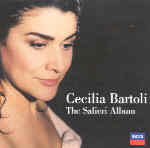Unfortunately, Antonio Salieri is best known as Mozart’s great Viennese rival, but in his time he not only was more famous but also was a respected teacher–of Schubert and Beethoven, to name two of his more illustrious students. He composed hundreds of works, among which are more than 40 operas. Nevertheless, Salieri has remained on the fringes of popularity, even during the bel canto revival and the fascination with Peter Schaffer’s play/movie Amadeus. But superstar Cecilia Bartoli, having relatively successfully ignited interest in Gluck and Vivaldi with CDs of arias from their little-known operas, now turns her attention to Salieri, and thanks to her, he may just become a quasi-household name. Here he proves himself a composer who wrote for virtuosos–and Bartoli is nothing if not a virtuoso.
This CD opens with an impressive bang. An aria from La secchia rapita (a ship-on-a-storm-tossed-sea simile aria) features a wild vocal line complete with maniacally fast coloratura, huge leaps, a range from low G to high D-flat (Bartoli flirts more and more with the soprano range while using her chest register even more forcefully), and vast dynamic changes. Fearless in her desire to “interpret”, Bartoli occasionally makes some unattractive sounds, here and elsewhere. Another aria from the same opera (and for a different character) features an obbligato oboe along with trumpets and drums; once more, the tessitura is quite high and the aria requires astonishing agility. Other arias–one from Palmira, regina di Persia, another from Armida, for example–are more introspective and are spun out with a graceful, seamless legato and seemingly endless pianissimo.
Everything we love about Bartoli is here: the intensity, absolute fluidity in execution, breath control, glorious trill, the ability to whisper or holler, and an identification with the character she’s portraying that makes the situation credible and involving for the listener. At the same time, we can’t overlook even more of a tendency to overstatement and breathiness than ever before–Bartoli seems to be conspiring, at times directly into our ears, and the very close miking emphasizes these annoying mannerisms. The rolled ‘r’ sounds are outrageous and irritating (track 4).
Throughout, the accompaniments are as superbly thought-out and played as we could hope for–the wacky pizzicato strings and solo wind and brass lines in an aria from La Cifra, for instance, will delight, and the flute and oboe obbligatos in an aria from La fiera d Venezia are Mozartian. Bartoli fans and lovers of great singing should not hesitate, but if you’re allergic to Bartoli’s mannerisms, beware: they’re practically visible here.
































